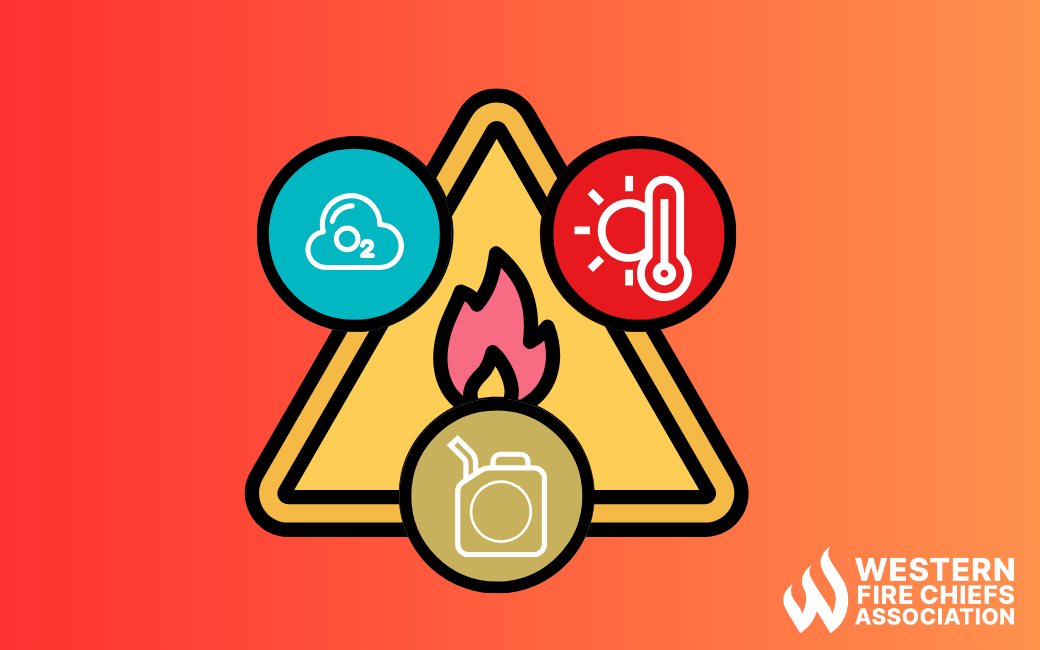Fire Pit Safety Tips
Stay safe around the campfire with tips from the Western Fire Chiefs Association. Learn essential precautions and practices for a worry-free outdoor campfire.
Dive into the fascinating science of wildfires. Explore the intricate dynamics of ignition, spread, and the ecological impact with guidance from the WFCA.
Published:November 28, 2023
Edited:March 1, 2024

Dive into the fascinating science of wildfires. Explore the intricate dynamics of ignition, spread, and the ecological impact with guidance from the WFCA.
Numerous factors contribute to how a wildfire is able to exist, ignite, behave, and spread. Acquiring an understanding of the science behind wildfires can provide the public with the necessary knowledge and tools to mitigate risks in their respective areas.
A wildfire requires three different components to burn: fuel, oxygen, and heat. This combination is known as the fire triangle. If any of these three are removed, the fire will be extinguished.1
Fuel: Fuel can be anything from wood or paper to flammable liquids, plugged-in electrics, or even metals such as potassium and magnesium.2
Oxygen: Fire requires the air to contain 16% oxygen in order to burn. The average air around us contains 21% oxygen.3
Heat: Heat is what ignites the fire, this can be matches, a lightning strike, or even cigarettes.
Wildfires can result from various factors, including both natural occurrences and human activities. Human activity is the leading cause of wildfires, although the majority of incidents occur accidentally. These activities consist of forgotten campfires, discarded cigarettes, or debris burning that spiraled out of control.7
While some environments rely on wildfires to release seeds from some plants and trees or clear out competing vegetation, there is also a huge threat to habitats and land quality when a wildfire passes through.4
Wildfires can be ignited by natural events such as lightning strikes, especially in dry areas where the fire can burn through fuel quickly. Additionally, volcanic eruptions, with their large release of hot material, can ignite fires in the surrounding area.
The type of fuel, weather, and area a fire is burning on can greatly affect the intensity and spread of the wildfire. These three factors are known as the fire behavior triangle.5 The term “fuel loads” refers to the amount of flammable material surrounding or near the fire. Dry fuel, like dead grass, leaves, or branches, are commonly found in drought conditions and is the ideal source for creating a high-intensity wildfire. The more of this fuel that is available, the easier it is for the high-intensity fire to spread.
The state of the fuel influences the fire’s behavior as well. When fire fuel contains large amounts of moisture, such as wet leaves, the fire will smolder and burn out quickly. Some trees and plants contain oils and resins that are fire-prone, meaning they are more likely to carry the fire and allow for fire growth.5
The term “fire weather” refers to any weather conditions that carry the risk of igniting a wildfire or facilitating the spread of an existing fire. The most common weather event that ignites wildfire is a lightning storm. When other fire weather characteristics are factored in, such as hot, dry, and windy conditions, the possibility of the fire spreading increases drastically.6
Wind plays a significant role in the spread of wildfires as it can pick up embers and push them to other areas resulting in spot fires. Strong winds can increase the rate at which a wildfire spreads, also by pushing the flames to jump from one fuel source to the next for rapid growth.
Climate change is the driving factor of increased fires and length of fire season. As the average global temperature increases, so do drought conditions. This results in less moisture in the soil, leading to hotter and drier areas with vegetation that is more likely to ignite and start a wildfire.
Stay safe around the campfire with tips from the Western Fire Chiefs Association. Learn essential precautions and practices for a worry-free outdoor campfire.
Discover essential firework safety tips to ensure a dazzling display without accidents. Learn how to celebrate responsibly with expert guidance from WFCA.
Explore the role of AI in wildfire prediction with guidance from the WFCA. Learn how advanced algorithms and data analytics enhance early detection and response.